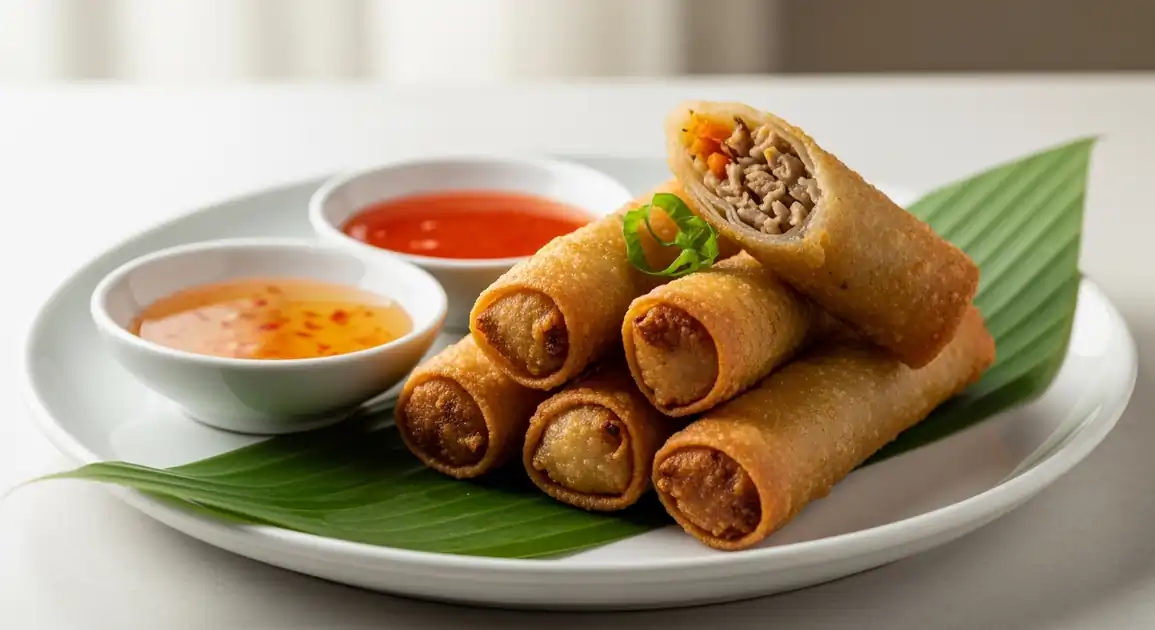Lumpia (Filipino Spring Rolls)
Lumpia

Description
In Manila, the bustling capital, lumpia is an ever-present street food and restaurant staple. You can find everything from humble street cart Lumpiang Shanghai to gourmet interpretations in upscale restaurants. Areas like Binondo (Chinatown) and Quiapo are hotspots for finding diverse and delicious lumpia.
Dietary Information
Serving information
Serving style
Street food served in paper or plastic bags. Carinderias/restaurants serve on plates. Sweet chili sauce and spiced vinegar are standard offerings for fried lumpia.
Quick facts
Street vendors: 10 AM - 10 PM approx. Carinderias: 7 AM - 7 PM approx. Restaurants/Malls: 10 AM - 9 PM or later.
Safety Tips
What to Look For
-
Vendor fries lumpia fresh to order or in small, continuous batches.
Ensures the lumpia is hot, maximally crispy, and hasn't been sitting around, reducing risk of contamination and sogginess.
-
Hot, reasonably clean frying oil.
Hot oil ensures quick cooking and a crispy, less greasy result. Avoid vendors using very dark, dirty, or low-temperature oil.
-
Crispy, golden-brown appearance.
Indicates proper frying. Avoid lumpia that looks pale, soggy, or overly dark/burnt.
-
Clean vendor station and utensils.
Good general hygiene practices are essential for food safety. Check how ingredients and money are handled.
-
High customer turnover.
A busy stall suggests the lumpia is popular and likely freshly made.
What to avoid
-
Pre-fried lumpia sitting in a large pile for extended periods.
Lumpia cools quickly and loses crispiness. Stored at improper temperatures, it can become a food safety risk.
-
Very dark, sludgy, or smoking oil.
Indicates old oil which affects taste and may contain harmful compounds. Smoking oil means it's too hot or degraded.
-
Soggy, oily, or limp lumpia.
Suggests improper frying temperature (too low), old lumpia, or excessive oil absorption.
-
Visible cross-contamination (e.g., handling money then food without washing).
Poor hygiene increases the risk of transferring germs to the food.
-
Unusually cheap lumpia compared to surrounding vendors.
Could potentially indicate use of lower quality ingredients or very old oil to cut costs.
Price information
Price range
Budget tips
- Street vendors in areas like Quiapo or near universities offer the lowest prices (10-25 PHP).
- Food court prices are slightly higher (25-40 PHP/piece).
- Restaurant appetizers will be the most expensive (150-350 PHP per serving of several pieces).
- Look for 'value meals' in carinderias that might include lumpia.
Value indicators
- Crispiness that lasts.
- Not overly oily.
- Authentic tasting filling (well-seasoned).
- Good filling-to-wrapper ratio.
- Freshly prepared dip (especially for vinegar).
Where to Find This Dish
Binondo (Chinatown)
Manila's Chinatown offers numerous eateries and stalls selling lumpia, including Chinese-influenced versions and classic Filipino styles.
Binondo Church, Ongpin Street, Eng Bee Tin Hopia
Lunchtime, Afternoon
Quiapo
Known for its bustling market and street vendors selling a variety of affordable street food, including lumpia.
Quiapo Church, Plaza Miranda, Underpasses
Daytime, Evening
University Belt (U-Belt)
Areas surrounding universities like UST, FEU, UE are packed with budget-friendly eateries and stalls catering to students.
UST Hospital, Recto Avenue, Morayta Street
Lunchtime, Afternoon
Makati / BGC Food Courts & Markets
Higher-end food courts in business districts and weekend markets often feature lumpia stalls.
Salcedo Market (Saturdays), Legazpi Market (Sundays), Mall food courts (Glorietta, Greenbelt, SM Aura)
Lunchtime, Weekends (markets)
Vendor Tips
- In Binondo, look for places specializing in fresh lumpia (sariwa) for a different experience.
- Don't hesitate to ask for extra vinegar or sweet chili sauce.
- Specify 'bagong luto' (newly cooked) if possible.
- Observe if the vendor keeps the cooked lumpia under a heat lamp, which helps maintain warmth but can affect crispiness over time.
How to Order
Regional Variations
-
Lumpiang Keso (Cheese Lumpia)
(Lumpiang Keso)
Simple lumpia filled primarily with cheese sticks, often cheddar, then fried. Popular snack.
-
Turon
(Turon)
While technically different (sweet), it uses the same wrapper. Filled with banana and jackfruit, coated in caramelized sugar. Often sold alongside savory lumpia.
-
Gourmet Lumpia
(Gourmet Lumpia)
Found in some Manila restaurants, featuring non-traditional fillings like sisig, adobo flakes, or seafood.
Cultural context
History
Lumpia traces its origins to Chinese spring rolls (lunpia/popiah), brought by traders and immigrants. Filipinos adapted it over centuries, integrating local ingredients and tastes. It has become deeply ingrained in Filipino culture, an essential dish at parties, fiestas, and family gatherings, symbolizing celebration and hospitality.
Local significance
In Manila, lumpia represents a quick, affordable, and satisfying meal or snack for people from all walks of life. It's a reliable go-to food found virtually everywhere.
Eating customs
- Eating on the go is common for street food lumpia.
- Combining both sweet chili and vinegar is sometimes done.
- Lumpiang Shanghai is often cut into smaller pieces when served at parties.